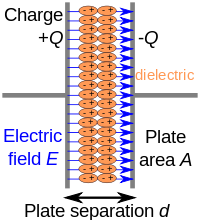
Photo from wikipedia
Abstract Lead-free ceramics of potassium-bismuth titanate K0.5Bi0.5TiO3 were obtained by a conventional sintering method under various technological conditions. The dielectric permittivity (ε) and dielectric loss (tan(δ)) measurements for these ceramics… Click to show full abstract
Abstract Lead-free ceramics of potassium-bismuth titanate K0.5Bi0.5TiO3 were obtained by a conventional sintering method under various technological conditions. The dielectric permittivity (ε) and dielectric loss (tan(δ)) measurements for these ceramics were carried out in the temperature range from 293 K to 873 K with the frequency range from 0.1 kHz to 2 MHz. An increase in dielectric permittivity with an increasing sintering temperature was observed. For the sample obtained at 1313 K and a 3.5-hour sintering time, the value of ε was about 4.55·103 (f = 100 kHz) which is twice higher than the value of ε for the sample obtained at a temperature of 1298 K and a 7-hours sintering time. For all samples, the maximum value of dielectric permittivity was shifted towards higher temperatures with an increasing frequency, which is a characteristic features of ferroelectric relaxor materials. The dielectric properties of all materials were very similar, especially in the case of dielectric loss. The values of tan(δ) at room temperature varied from about 0.07 at 0.1 kHz to 0.1 at 2 MHz. The Raman studies were performed at room temperature. No significant changes were observed for different sintering temperatures and times for all samples. The presented material can be a starting point for the development of new ferroelectric relaxor materials.
Journal Title: Ferroelectrics
Year Published: 2019
Link to full text (if available)
Share on Social Media: Sign Up to like & get
recommendations!